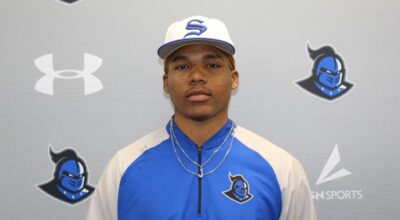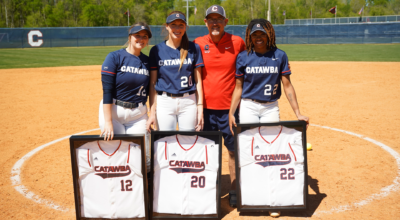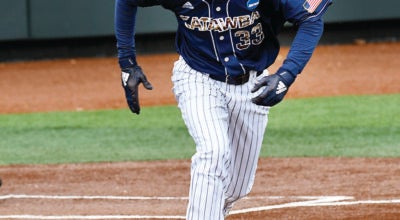NASCAR still looking for its Danica Patrick or Ashley Force
Published 12:00 am Monday, May 19, 2008
By JENNA FRYER
AP Auto Racing Writer
CHARLOTTE, N.C. (AP) — It was a matchup NASCAR could only dream of: Melanie Troxel and Ashley Force going head-to-head in the first all-female Funny Car elimination round.
Troxel won the round, made it to the finals and ultimately claimed the title Sunday at Thunder Valley Nationals – making her the first woman in NHRA history to win in both its nitro classes. Troxel downplayed the significance of her matchup with Force, trying hard to remove gender from the historic moment.
“Everybody wants to make a big story about Ashley and I running against each other,” she said. “For me, it’s not about the other female out here. I think it’s pretty sad if we have to just compare ourselves against each other.”
She’s right, of course. Female competitors are no longer a sideshow in most forms of racing, and Troxel’s championship proved women are succeeding at a consistent pace.
Except in NASCAR, that is.
As the most celebrated day in motorsports approaches this week, the differences in gender equality have never been more profound. Danica Patrick headlines a trio of three women who will compete Sunday in the Indianapolis 500, but NASCAR won’t have a single woman in its showcase Coca-Cola 600 later that day or in any of the NASCAR-sanctioned events spanning 10 days of racing at Lowe’s Motor Speedway.
Three decades after Janet Guthrie became the first woman to race in the 600, NASCAR still boasts all-male fields at its premier Sprint Cup level. In fact, no woman has raced in the 600 since Guthrie, and the Cup series has not had a female racer since Shawna Robinson ran seven events in 2002.
“I don’t think it’s something NASCAR is really concerned about. A female driver is not something they really need,” said veteran racer Mike Wallace. “For a while, a lot of people thought it was a novelty. And I’ve had people close to me say ‘Girls can’t drive.’
“Well, maybe they can’t. But maybe there are one or two who can, and we just need to give them a chance.”
Wallace speaks not as a driver with 605 career starts spanning NASCAR’s top three series, but as the father of a 20-year-old female racer who dreams of someday making it to the Cup Series. Although she has just one career start in the Truck Series, Chrissy Wallace has taken over the role as NASCAR’s best bet to make it to the big time.
She’s doing it on her own, piecing together a schedule of seven planned truck races this year for Germain Racing. She was a respectable 18th in her debut at tricky Martinsville Speedway and hopes improvement over her next several races will lead to the funding she needs to run a full schedule next season.
“You have to have decent finishes and win races to attract a sponsor,” Chrissy Wallace said. “If we don’t get one, we’re probably only going to be able to do a limited schedule next season. It’s all based on performance.”
It’s all part of the vicious cycle in racing, where success is as much dependent on financing as talent.
It takes an extraordinary financial commitment to help a child grow from go-karts to bandaleros to late models and maybe someday into stock cars. Not every family has the resources – Denny Hamlin’s parents mortgaged everything and nearly went broke helping him.
Drivers vying for the top level are getting younger and younger in NASCAR, where team owners constantly are scouring short tracks for the next big thing. Just look at Joe Gibbs Racing, which is counting the days until protege Joey Logano’s 18th birthday next month, when he can make his Nationwide Series debut.
“The issue we have to confront is one of preparation,” said Marcus Jadotte, who oversees NASCAR’s diversity issues. “We need to get more young women involved at a young age and hold that interest so their developmental path is that of a normal young male driver.”
NASCAR recently began a financial partnership with World Karting Association to help fund opportunities for young female and minority drivers through its Drive for Diversity program. The sanctioning body recognizes capturing the interest of a young driver and holding it until they reach NASCAR’s minimum participation age of 16 can be difficult, and providing opportunities for development at the karting level is a start.
The current nine-member D4D program has three women in it, but Kristin Bumbera, Katie Hagar and Lindsey King all are competing on much lower levels of NASCAR-sanctioned racing.
“It is impossible for me or anyone at NASCAR to predict how fast a professional athlete is going to develop,” Jadotte said. “Our job is to create as many opportunities for them to develop and improve their skill level, then demonstrate that skill level to the industry to attract team and sponsorship support that will help them move up the ladder.”
Chrissy Wallace didn’t consider racing a possible career until three years ago, and s he’s been playing catch-up ever since.
Although she’s won at every level, the sponsorship needed to continue her career isn’t pouring in. It has helped that she has a famous last name and connections – two-time Cup Series champion Tony Stewart has provided both financial support and advice of late – but there’s still a stigma that exists among major corporations with money to spend on sponsorship.
Companies might shy away from sponsoring a woman because there’s no proven record of success among female racers in NASCAR. Others might simply be gun shy after Erin Crocker became involved with Ray Evernham, her car owner.
Crocker acknowledged the relationship stalled the sponsorship she needed to continue her career at the top level, and Wallace said she believes other women are feeling the affects.
“People question if that’s going to be the same thing that happens with me, but we’re two totally different people,” said Wallace, who considers herself friendly with Crocker. “It’s kind of unfair that all female drivers are often based on her experiences.
“There’s a lot of female drivers out there who are talented and work hard.”





